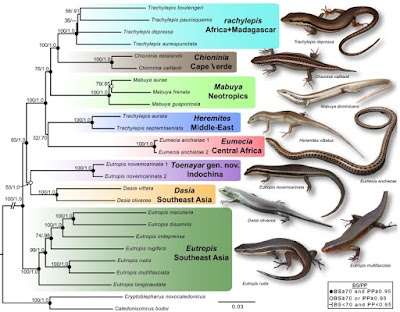Despite an abundance of phylogenetic studies focused on intrageneric relationships of members of the Mabuya group, the intergeneric relationships between the genera within the circumtropical Mabuya group have remained difficult to resolve. Leer más.







Despite an abundance of phylogenetic studies focused on intrageneric relationships of members of the Mabuya group, the intergeneric relationships between the genera within the circumtropical Mabuya group have remained difficult to resolve. Leer más.

Artículos publicados. Volumen 25, 2014
Editorial PDF.
Historia natural
1. Winter habitat for Triturus pygmaeus. Autores: Miguel Moya & Stephen D. Busack. PDF.
2. Dos casos de períodos prolongados de incubación en Chamaeleo chamaeleon. Autores: Miguel Ángel Farfán, Antonio Enrique Nadales, Araceli Martín, José Guevara & Joaquín Santaolalla. PDF.
3. First record of a tunnel breeding population of Pleurodeles waltl and two other records of Iberian cave dwelling urodeles. Autores: David Herrero & Arlo Hinckley. PDF.
4. Albinism in Pleurodeles waltl. Autores: Stephen D. Busack and David Donaire. PDF.
5. Complete albinism in a larval Triturus pygmaeus. Autor: Stephen D. Busack. PDF.
6. Predation of Craugastor podiciferus (Anura: Craugastoridae) by Catharus frantzii (Passeriformes: Turdidae) in a Neotropical cloud forest. Autores: Víctor Acosta & Orlando Morún. PDF.
7. El tamaño importa: tractos digestivos y nematodos Pharyngodonidae parásitos de reptiles. Autor: Vicente Roca. PDF.
8. Notas sobre distracción caudal en ofidios del norte de África y Oriente Medio. Autores: Raúl León, Gabriel Martínez & Baudilio Rebollo. PDF.
9. Hábitat reproductor y ciclo anual de Discoglossus galganoi en acantilados marinos de Galicia. Autor: Pedro Galán. PDF.
10. Probable piscivoría en Mastigodryas bifossatus (Serpentes: Colubridae). Autores: Pier Cacciali y Michael Notario Roa. PDF.
11. Depredación de Pelophylax perezi sobre un ejemplar adulto de Hyla meridionalis. Autor: Eudald Pujol-Buxó. PDF.
12. Predation on Trachylepis socotrana by Lanius meridionalis. Autores: Eudald Pujol-Buxó, Raquel Vasconcelos, Ahmed Saeed Suleiman, Xavier Santos & Gustavo A. Llorente. PDF.
Distribución
13. Origen, distribución y estado de conservación de la población aislada de Zamenis longissimus de los Montes de León (NW de la península Ibérica). Autores: Martiño Cabana, José Eduardo Nieto Santín, Rafael Vázquez Graña & Luís Pelayo García González. PDF.
14. Contribución al conocimiento corológico de Myriopholis algeriensis en el suroeste de Marruecos. Autores: Luis García-Cardenete, Francisco Jiménez-Cazalla, Juan Ramón Fernández-Cardenete, Aitor Valdeón, M. T. Pérez-García, & F. J. Herrera Sánchez. PDF.
15. New record of Salamandra algira isolated on the north-western Tingitana peninsula, with some notes on the reproductive modes within the species. Autores: Guillermo Velo-Antón, Luis García-Cardenete, Francisco Jiménez Cazalla, Fernando Martínez-Freiría. PDF.
16. Lacerta schreiberi, nueva especie de reptil para la Zona Periférica de Protección del Parque Nacional de Monfragüe (Cáceres, España). Autores: Daniel Fernández-Ortín y Amalio Toboso-Borrella. PDF.
17. Revisión de la distribución y abundancia de la herpetofauna en las Islas Chafarinas: Datos históricos vs. tendencias poblacionales. Autores: Roberto García-Roa, Jesús Ortega, Pilar López, Emilio Civantos & José Martín. PDF.
Conservación
18. The nursery trade. A stowaway gecko for a no return trip outside its native range. Autores: Jean Michel Delaugerre & Julie Holthof. PDF.
19. Malla metálica de cerramiento, posible amenaza para galápagos. Autores: Pedro L. Hernández-Sastre & César Ayres. PDF.
20. Utilidad de la legislación sobre invasoras para la conservación de las especies de galápagos ibéricos. Autor: Alfonso Balmori. PDF.
21. Regeneración de la extremidad anterior en un tritón del Montseny (Calotriton arnoldii) tras su amputación quirúrgica. Autores: Elena Obon, Albert Martínez-Silvestre, Francesc Carbonell, Mónica Alonso, Raquel Larios, Emilio Valbuena-Ureña & Joaquim Soler. PDF.
22. Distribución, fitosociología y conservación de Chalcides bedriagai en el municipio de Cangas (Pontevedra, NO España). Autores: Juan José Pino-Pérez, Celso Carballo-Leiro & Rubén Pino-Pérez. PDF.
23. Sobre el galápago europeo Emys orbicularis en el sur de Cádiz (SO de la península Ibérica). Autores: Francisco Jiménez-Cazalla & Manuel Castro-Rodríguez. PDF.
24. La importancia de los refugios de Timon lepidus en los yacimientos arqueológicos. Autor: Joaquín Márquez. PDF.
Last month, turtle experts thought there were fewer than 3,000 Philippine forest turtles left in the world. They were shocked when they found 3,800 more — stacked on top of each other in a cement tank in a Chinese-owned Philippine warehouse. Leer más.
Un hombre que el domingo por la mañana estaba realizado pesca submarina en el Port de ses Caletes se encontró con una culebra de herradura (Hemorrhois hippocrepis) que estaba nadando alrededor de uno de los pequeños islotes de la zona norte de este cala, muy cerca de la orilla. Leer más.

Recently a small group of Cambridgeshire and Peterborough Amphibian and Reptile Group (CPARG) members (including myself) were given the chance to visit the RSPB’s Lodge Nature Reserve in Sandy, Bedfordshire. We were there to find out about the population of natterjack toads (Epidalea calamita) present at the site, find out what’s being done to conserve them and to hopefully catch a glimpse of one. Leer más.
